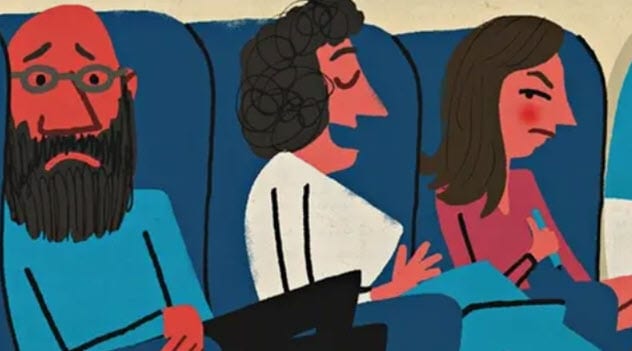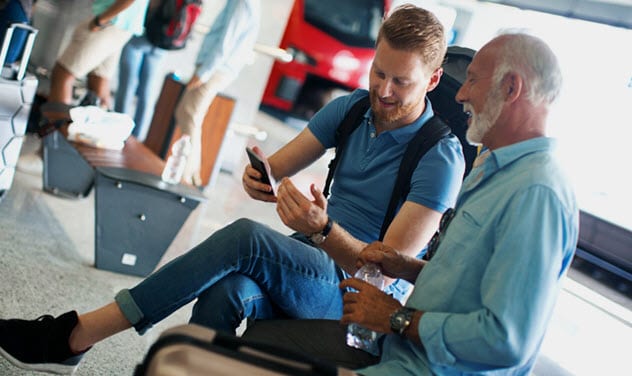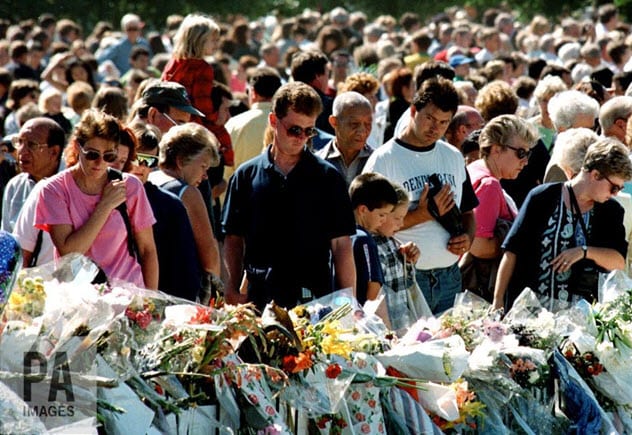 Mysteries
Mysteries  Mysteries
Mysteries  History
History 10 Surprising Stories About the Texas Rangers
 Humans
Humans 10 Philosophers Who Were Driven Mad by Their Own Theories
 Miscellaneous
Miscellaneous 10 Video-Game-Worthy Weapons and Armors from History
 Weird Stuff
Weird Stuff 10 Psychics Who Accurately Predicted Wartime Events
 The Arts
The Arts 10 Pieces of Art Inspired by a Broken Heart
 Health
Health 10 Science Fiction-Sounding New Medical Treatments
 History
History 10 Surprising Facts About the Father of Submarine Warfare
 Space
Space Ten Astonishing New Insights into Alien Worlds
 Weird Stuff
Weird Stuff 10 Bizarre Summer Solstice Rituals Still Practiced Today
 Mysteries
Mysteries Top 10 Haunting Facts About the Ghost Ship MV Alta
 History
History 10 Surprising Stories About the Texas Rangers
 Humans
Humans 10 Philosophers Who Were Driven Mad by Their Own Theories
Who's Behind Listverse?

Jamie Frater
Head Editor
Jamie founded Listverse due to an insatiable desire to share fascinating, obscure, and bizarre facts. He has been a guest speaker on numerous national radio and television stations and is a five time published author.
More About Us Miscellaneous
Miscellaneous 10 Video-Game-Worthy Weapons and Armors from History
 Weird Stuff
Weird Stuff 10 Psychics Who Accurately Predicted Wartime Events
 The Arts
The Arts 10 Pieces of Art Inspired by a Broken Heart
 Health
Health 10 Science Fiction-Sounding New Medical Treatments
 History
History 10 Surprising Facts About the Father of Submarine Warfare
 Space
Space Ten Astonishing New Insights into Alien Worlds
 Weird Stuff
Weird Stuff 10 Bizarre Summer Solstice Rituals Still Practiced Today
Top 10 Weird Facts About Strangers
These days, the word “stranger” is mostly one-dimensional. It conjures up the image of a blurry-faced human who might do something criminal if shown too much trust. However, some do earn our trust for no apparent reason. People even tell their secrets to strangers.
This field is also rich for experiments. Sociologists have buzzed strangers in a room with lavender, found Britain is one big family, and discovered why some commuters hate, well, other commuters.
10 Fairness Between Strangers

An unusual perk in the past was to trust a stranger. Considering the violence in hunter-gather and later Neolithic societies, this sounds plain wrong. However, safety was still the main concern and this trust was only extended in the trading sector.
Researchers believe that small groups who welcomed unknown trading parties would have lived better than those who did not. The same counted for the spread of organized religion, which would have brought some order and stability to growing communities.
In 2010, a massive study involving 15 countries and over 2,000 volunteers found that small communities often showed less fairness in trade and, ironically, a lower rate of punishment against unfair offers. The world’s biggest players in trade made better offers and had less tolerance for chancers.
This suggested that humans evolved for thousands of years to either be closed off and stagnate or to give when trading with strangers and flourish.[1]
9 Traveling Together Divides Strangers

In 2012, Esther Kim traveled for thousands of miles by bus. The sociologist from Yale University wanted to find out why commuters are not the chattiest bunch. She discovered that people often went to great lengths to keep the seat next to them empty—purely to prevent a stranger from sitting down.
Some placed luggage on the seat or lied, claiming to be holding the space for a friend. According to Kim, one unspoken rule was that it was rude to sit down next to somebody if the bus was not full.
When the bus was at full capacity and everyone sat next to each other, commuters still put up barriers. They avoided eye contact, worked on their phones, or adopted what Kim called the “hate stare.”[2]
Her study concluded that most people were concerned over safety. After all, many buses, subways, and trains are poorly lit and frustratingly force a person to spend time with strangers in a confined space. Another big reason was that commuters just wanted to be left alone.
8 The Chicago Experiment

In 2019, researchers asked commuters to strike up a conversation with a stranger. Although most feared that the other passengers would give them the evil eye, the result was surprising. Each volunteer found that the person sitting next to them was happy to talk.
The researchers then encouraged people to chat with strangers in taxis, buses, trains, and even waiting rooms. The same thing happened. These large-scale and mutually enjoyable connections countered the belief that reaching out to strangers makes everyone uncomfortable all the time.
However, the scientists were quick to point out that the study did not give license to talk the ear off somebody who did not reciprocate. As sociologist Esther Kim found out, sometimes people really do not want to be disturbed. But for those who do, a chat with a friendly stranger with good intentions can make a boring commute better and even make people feel a little bit more connected.[3]
7 Strangers Pick Better Profile Pictures

In 2017, two universities in Australia performed an unusual study. They wanted to see if people could pick their own best profile pictures or whether strangers did a better job. The results showed that people sucked at choosing their own.
The universities chose 12 Facebook photos of every volunteer. The 102 students had to rate their own pictures based on positive qualities such as how dominant, attractive, or confident they appeared. Each also had to pick one as their Facebook profile picture.
Afterward, a group of 160 strangers rated all the students’ images for the same positive qualities. Surprisingly, the strangers consistently favored better photos of the students than the students had chosen for themselves. The researchers could not say why but suspected a built-in bias. In other words, people often overestimate how good they look.
These days, profile pictures are important. The right image could snag a job or the perfect soulmate. Unfortunately, another bias—making split-second decisions about a person based on their appearance—can influence employers and prospective dates to move on when a profile picture fails to resonate.[4]
6 Lavender Creates Mutual Trust

In 2015, Dutch researchers asked volunteers to play a trust game. The rules for each two-person game were simple. Money was given to one person. That individual could leave with the entire sum or share it with the other person. If the second player did receive money, he could also choose to leave or return some of his newfound wealth to the first player.
Here’s why the initial player had an incentive to share: Any money given away was tripled for the receiver. If the receiver was willing to share that tripled sum with the donor, the original player could end up with more than he had given away and both players would be better off than they were at the start of the game.
But that’s where trust came in. The second player could walk away and leave the original donor with less than he had initially received or even nothing (depending on how much he had given away).
Ninety volunteers were divided into pairs. Then each pair played the trust game in one of three rooms. The first room was infused with the aroma of lavender, the second was scented with peppermint, and the third remained neutral. None of the 90 volunteers knew each other, but whoever played in the “lavender” room shared more funds than the rest.
The reason was interesting. Lavender is known for its calming effect. The human olfactory nerve deals with smells and is connected to a brain region that controls how we trust others.
It would appear that lavender soothes the brain’s “trust center,” something the researchers said could be used to influence others. For example, customers might trust a product more and contracts could get clinched during a lavender-scented meeting.[5]
5 We Overshare Secrets With Strangers

They are everywhere. That airplane passenger explaining his extramarital affair, the person in the queue who talks about her bankruptcy, or the person on the bus confessing his hatred for the socks his kids got him for Christmas. Sometimes, we are those people.
There are several reasons why secrets are more readily shared with strangers. One the one hand, some individuals talk too much because they lack discretion and are triggered by the mere availability of a listener. However, there are deeper emotional causes that motivate people to turn to strangers rather than to family or friends.
Imagine telling the kids that those socks were eyeball-shriveling awful or telling friends about one’s financial problems. Sometimes, one needs to confess something without the consequences of hurting someone or looking bad. Most people also do not want the pressure of unhelpful advice from loved ones, who might expect them to follow up on it.[6]
4 Why We Trust Strangers

Most adults are wary of strangers. Years of warnings about kidnappers, media stories of crime victims, and personal experiences all make people mistrust a new face. However, there are times when a perfect stranger seems trustworthy without an obvious reason. As it turns out, there is an explanation.
A study published in 2018 found that the choice to trust someone is based on past experience. More precisely, how people looked and whether they resembled loved ones or enemies.
Few are aware of it, but one is more likely to trust strangers who look like Mom or that cop who saved cousin Bob. People also recoil from strangers who resemble a hated ex or a friend who betrayed them. In fact, somebody with the barest resemblance to that obnoxious neighbor could earn one’s wrath.
This bias is hardwired into the brain and reinforced over the years, which is why judgments sometimes happen subconsciously. This is usually why a stranger—who looks like a deceased and much-missed uncle—already has one foot in the door.[7]
3 Event Grief

Thanks to television and newspapers, nearly everyone gets swept up in a stranger’s death at least once in their life. For example, precious few of the mourners knew Princess Diana, but her passing—and the ensuing media frenzy—drew the largest public outpouring of grief in history over a single death.
One journalist coined an apt term for mass mourning over a stranger: “event grief.” It is the reason why thousands send cards and gifts to the families of missing or murdered kids. For some reason, people gather, whether it is to put flowers at a crash site or to hold candlelight vigils praying for a safe return.
Event grief appears to be a psychological response to a tragedy, acting as a glue to bond people together and share comfort. Of course, some just get off on the media hype. But event grief is a real emotion for those who sympathize with the victims and their families, even though they are complete strangers (as are most of their fellow mourners). It is perhaps one of the more incredible things that strangers do together.[8]
2 Cuddle Therapy

Cuddling is a mainstay for couples, but few know that cuddling with strangers is a thriving business (as a strictly platonic affair). The clientele includes those needing comfort, the recently bereaved, and the lonely.
One professional cuddler is Rebekka Mikkola from Finland. She starts a session by talking with the customer in a quiet, dimly lit room. After assessing the person’s feelings about touching, the session begins. Lasting about an hour, Mikkola will hug, hold, stroke somebody’s hair, massage their fingers, and spoon. She only does something when the client is comfortable with it.
The whole thing might sound like an invitation for risky business, but in all her 1,000 hours of cuddling experience, the therapist had never received unwelcome advances. However, nearly half her clients weep in her arms. Some succumb to the “cuddle coma,” becoming sluggish and experiencing low brain function due to extreme relaxation.[9]
Platonic snuggling has other great benefits, including heightened feelings of well-being and confidence as well as reduced blood pressure and anxiety.
1 Many Strangers Are Relatives

A genealogy service called AncestryDNA took an in-depth look at British families. The study, which was done in 2015, found that the average Brit had a crowd of cousins. The statistics were wild. The average person had 193,000 cousins traipsing around Britain, around two per 2.6 square kilometers (1 mi2).
If he or she lived in London and used the city’s Underground (aka the Tube), the chance of having relatives riding with them became even more staggering. In fact, an estimated 12,000 strangers commuting with the person could be the individual’s cousins.
As amazing as it is that every stranger encountered by a British person has a 1-in-300 chance of being family, it cannot beat the discovery of a 2013 study performed by the University of California. The researchers concluded that all people of European descent were one ginormous family. More remarkably, two citizens living at the opposite ends of Europe could expect to find millions of mutual ancestors in just the last 1,000 years.[10]
Read more weird facts about strangers on 10 People Who Secretly Lived In Other People’s Houses and 10 Creepy Photos Of People Unaware They Are With A Serial Killer.








